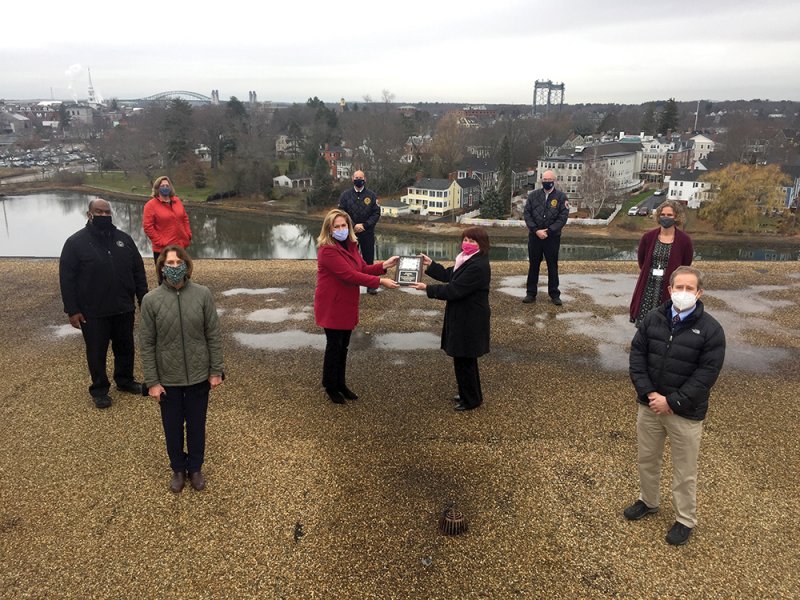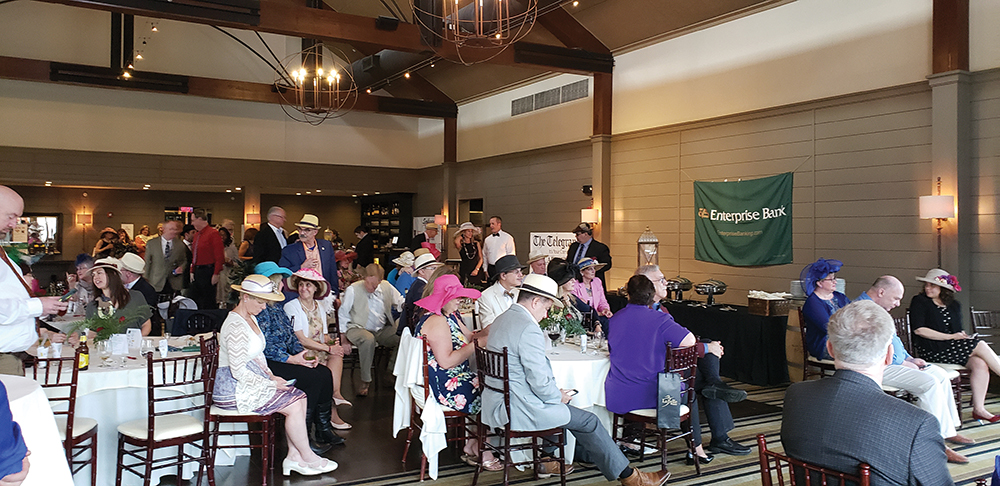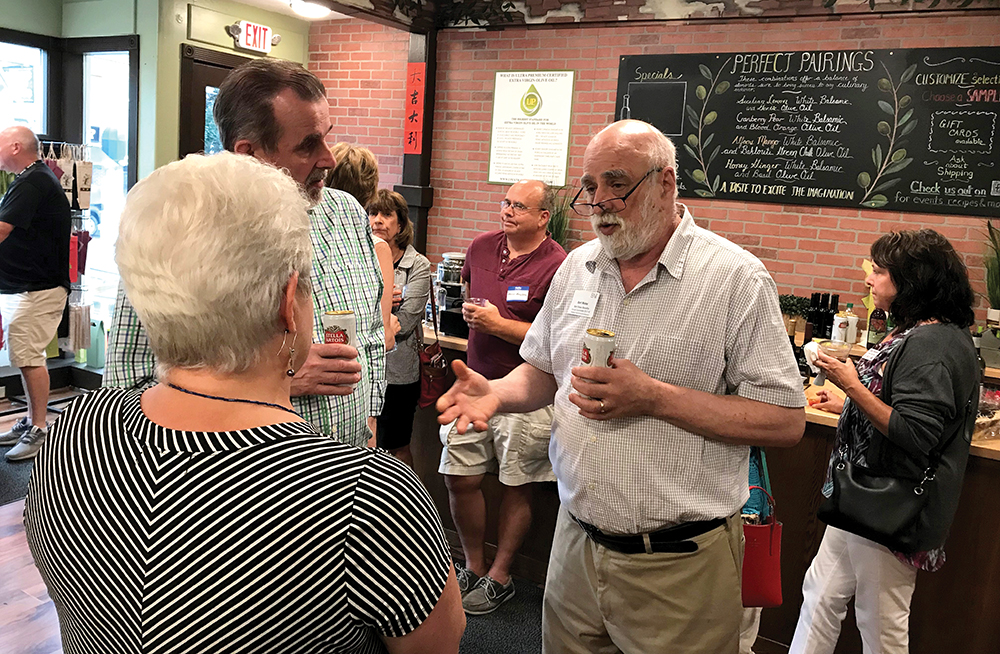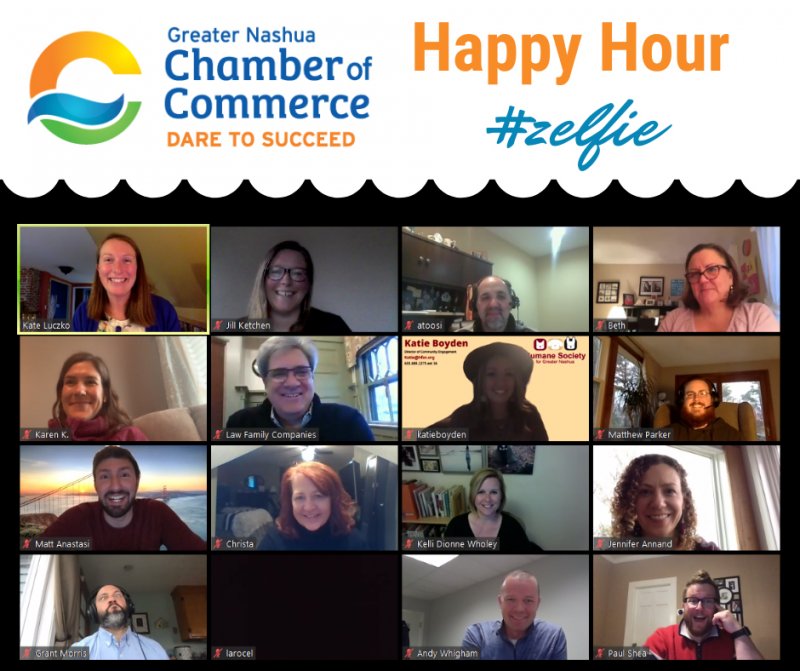 Chamber Collaborative of Greater Portsmouth then-president Valerie Rochon, holding plaque, right, presented a Pandemic Powerhouse Award to the staff of the City of Portsmouth in September. Courtesy photo.
Chamber Collaborative of Greater Portsmouth then-president Valerie Rochon, holding plaque, right, presented a Pandemic Powerhouse Award to the staff of the City of Portsmouth in September. Courtesy photo.
After a year of helping businesses power through the pandemic, chamber of commerce executives statewide are examining how their role is changing.
Chamber leaders have been battle tested in the past 12 months and faced the same challenges as their members––reduced revenue and cutting staff. Except for one thing. Chambers did not have access to the same federal and state relief funds until recently. While many businesses and nonprofits received forgivable loans, disaster relief and grants, chambers initially only received government contracts for support. It wasn’t until last fall that a second round of PPP loans changed the rules for nonprofits, making chambers eligible for aid.
Donna Morris, who has led the Greater Salem Chamber of Commerce for 15 years, says the past year has been unlike any other. “You have to adapt to survive.”
Early Struggles
When the pandemic struck, events, chambers’ major revenue stream, vaporized before ultimately going virtual. Secondarily, many members could no longer afford their dues and canceled or suspended memberships.
“While we lost some members, we tried to work with them. We didn’t want to drop members when they’ve been at our side,” says Wendy Hunt, chair of the NH Association of Chamber of Commerce Executives. At press time Hunt was transitioning from her role as president and CEO of the Greater Merrimack-Souhegan Valley Chamber to take the helm of the Greater Nashua Chamber of Commerce.

The Greater Merrimack-Souhegan Valley Chamber canceled its 2020 Kentucky Derby event, seen here in 2019. Courtesy photo.
The Mount Washington Valley Chamber furloughed all four full-time employees and one part-time employee in April 2020. But not wanting to leave her members without resources, Executive Director Janice Crawford volunteered to distribute COVID-related information to area businesses and held stakeholder meetings until the chamber could bring back its staff in August.
The Littleton Area Chamber laid off its executive director, Nathan Karol (who has since started his own B-to-B consulting firm, Cardinal Consulting) and the chamber is now being run by a volunteer board of directors. Karol says, “There weren’t funds to pay somebody because there were no funds coming in.” He says he was forging a plan to address the chamber’s finances when the pandemic hit. “We were going to have a full slate of activities and members opportunities. We had a budget that was really ambitious and would chip away at some of the debt they had.”
The Littleton Chamber even sent a letter to members asking for donations that kept their executive director on staff through July.
Business Lifeline
When the pandemic hit, businesses scrambled to decipher changing guidelines, find assistance and keep the doors open. “The image that comes to mind is a firehose,” says Valerie Rochon, president and chief collaborator of the Chamber Collaborative of Greater Portsmouth who will be retiring this spring. “So much information was coming out so quickly.”
In response, chambers transformed into information clearinghouses for their communities, not just members. Rochon says information was quickly funneled to the communications team, who distributed it through online postings, e-newsletters and social media, whether it was about securing PPE, loan programs or contacts that could help small businesses stay afloat.
The Greater Nashua Chamber launched a twice-weekly newsletter to give members timely information, says Kate Luczko, president and CEO, who also announced she is stepping down from her position.
The Greater Keene and Peterborough Chamber, which merged, also saw the need to disperse information to area businesses and created a COVID page online that was updated daily, says Phil Suter, president and CEO. “We didn’t fold our tent and go home because we were thrown this curve ball. We looked at what we could provide of value.” And the chamber held virtual community conversations to keep businesses informed and connected, Suter says.
“I was literally on the phone with businesses helping them, in some cases through Zoom, to explain how to apply for grants,” says Tracy Hutchins, president and CEO of the Upper Valley Business Alliance. “We still have some members who are not computer savvy. The EIDL program was only online. … they [businesses] were giving me information, and I was typing it in for them because they did not know how to apply.” Hutchins says she was also working one-on-one with members who were self-employed and applied for relief funds, and their application was lost or denied. “I would follow up with that. I had members apply for unemployment, and I was following up with the Department of Employment Services on their behalf.
Anything that was going to help our members we did and followed up on,” she says.
The NH Association of Chamber of Commerce Executives (NHACCE) coordinated an online calendar for all NH chambers, which listed workshops, webinars and resources available to businesses, says Hunt.
Without in-person events, chambers leaned into their role as advocates for the business community. “We completely shifted our role as a destination marketing organization to a more traditional chamber role as an information gatherer and getting information to our members on every topic inundating our email,” says Crawford of the Mount Washington Valley Chamber.
 An after hours event, prior to the pandemic, held by the Mount Washington Valley Chamber of Commerce. Courtesy photo.
An after hours event, prior to the pandemic, held by the Mount Washington Valley Chamber of Commerce. Courtesy photo.
Crawford says they also spoke with local governments to allow outdoor dining. They created a local reopening task force that produced its own set of guidelines and hosted Zoom meetings with industry leaders to hear concerns, she says.
“The impact of COVID fundamentally changed the direction of our year in unexpected ways,” says Michael Skelton of the Greater Manchester Chamber. The chamber had just completed renovating its office to provide more meeting space when the pandemic shut the office down. “All of our plans for 2020 went out the window, and our focus was what do our members need,” he says.
Chambers Left Out in the Cold
When chambers weren’t eligible for federal and state relief loans, Rochon of Portsmouth says she was able to access $7,000 early on through a specific workforce program, but that was it. Meanwhile, her major sources of income—events and sponsorships—dried up.
When the Portsmouth Collaborative began invoicing for its 2020 fiscal year in July, it expected to lose about 30% of its membership. Rochon had to lay off two of the seven-member staff. “Other chambers lost all of their staff or just kept the executive director. It’s been devastating for chambers,” Rochon says.
The Collaborative established a Business-to-Business Membership Fund, whereby members who could afford to do so donated funds to help those less fortunate pay their dues. It raised $10,000, Rochon says, allowing it to subsidize memberships. The Chamber Collaborative also received a $15,000 donation from First Seacoast Bank that went into that fund.
The uncertainty over memberships pervaded every chamber. “There were some hard decisions and scary times,” Skelton of the Manchester Chamber says. “I would go to the post office once a week to pick up the mail and see firsthand the pace of renewals.” Ultimately the Manchester Chamber ended 2020 financially stable, Skelton says, but they did so by reducing expenses, deferring projects and reducing staff.
Knowing new memberships would be down, the Manchester Chamber instead focused on member retention, Skelton says, offering payment plans and dues deferral.
Crawford says the Mount Washington Chamber saw several members not renew because of the economic uncertainty, and it lost its ski pass program as panicked ski areas opted out.
Events Evolve
One of the biggest hits was the loss of live events. While the focus of many chambers pre-pandemic was lobbying and tourism, events were a tangible member benefit, generating revenue through ticket sales and sponsorships.
For some members, their chamber experience is defined by networking. Skelton says, “We can’t wait to get back to bringing people together to discuss shared values and how to make our community better.” He adds the pandemic demonstrated chambers are far more than event producers. “The chamber is a unifying voice in the community that can amplify needs and concerns in times of crisis,” Skelton says.
Chambers quickly pivoted to online events. “We learned doing a virtual event is not as simple as taking an in-person event and making it virtual. You have to build it from the ground up,” Skelton says, adding that switching to virtual events was a process of trial and error and that virtual event fatigue has set in.
The Chamber Collaborative moved some events online but with mixed results. Its Business After Hours events usually attract up to 300 people, but online versions averaged 20 to 25, Rochon says. “We are all Zoomed out by 3 o’clock in the afternoon.”
The Salem Chamber was among the first to resume in-person events last summer. It held an event with Gov. Chris Sununu in July with socially distanced tables and masked attendees (the chamber even had a mask sponsor). It held its annual golf tournament and its annual dinner, but both on a smaller scale, Morris says. Not all live events made a return. Instead of holding its annual Restaurant Expo, the Salem Chamber developed a coupon book with take-out offers from area restaurants, Morris says. “It helped with the chamber’s revenue and helps people with take-out, keeps a revenue stream for restaurants, and funds our scholarship committee,” she says.
Hutchins of the Upper Valley says while they switched to virtual events, attendance has dropped off, and they’ve canceled several community events indefinitely.
Strategic Partnerships
Fairly early in the pandemic, Taylor Caswell, commissioner of the NH Department of Business and Economic Affairs (BEA), and his team identified chambers as a critical avenue for distributing information and began meeting weekly with chamber executives.
Recognizing chambers had limited access to relief funds, Caswell and Gov. Sununu carved out a $2 million contract to support chamber projects to assist with COVID economic recovery, Rochon says. Through this program, chambers were split into seven regions to work cooperatively in delivering support services.
One of the regions is a partnership between seven chambers—Concord, Derry/Londonderry, Hudson, Manchester, Merrimack/Souhegan Valley, Nashua and Salem—that have dubbed themselves the NH Commerce Corridor. They established a website highlighting resources for businesses and visitors.

Many chambers transitioned to virtual events including, the Greater Nashua Chamber’s Happy Hour event.
“We’re not heavy on tourism like the White Mountains and the Seacoast,” Hunt says, explaining the NH Commerce Corridor is focused on workforce development, especially in the life sciences/biomed, manufacturing, financial services and health care sectors. And each chamber partner takes on a different aspect of the support services, such as Morris of the Salem Chamber organizing a virtual job fair.
“We had about 250 to 300 attendees and 70 to 80 different employers,” Morris says. “We had people from California interviewing. That’s really amazing.”
Skelton says this effort allowed them to create a regional brand that he expects will last beyond the COVID crisis.
Other chambers focused on economic recovery, programs to boost consumer confidence by having stores and restaurants pledge to follow COVID guidelines, and helping with businesses’ recruitment efforts.
The six Seacoast chambers had a formal alliance for years so they were able to hit the ground running when the state awarded the group $300,000, Rochon says. They launched visitseacoastnh.com and six business assistance programs. Chief among those was Seacoast Safe, in which businesses pledged to adopt safety measures to prevent viral spread.
Other initiatives included a virtual job fair, marketing the region on social media and producing six 15-second videos promoting “staycations” in the region.
Chambers in the White Mountains used funds to examine how tourism had changed because of COVID and how to adjust the marketing. They also launched a program to educate visitors on how to enjoy outdoor recreation responsibly. “We have to let people know we love our area, and we want to keep it beautiful and pristine,” Crawford says of dealing with tourists who litter and relieve themselves in inappropriate places. “We were facing behaviors one wouldn’t think we would ever see,” she says.
In response, the collaborative also created a visitor pledge to remind tourists of the behavior needed to preserve the region.
Another challenge Crawford points to is that state money arrived in October but had to be spent by December. Their region’s efforts included a “100 Mile Challenge,” a scavenger hunt for visitors driving the scenic byways during foliage season. “You had to show you had a cup of coffee, you ate in a restaurant,” Crawford says. Prizes were given to 10 winners weekly between October and December, with one grand prize winner receiving a week at the Mount Washington Hotel. More than 2,000 visitors participated, sharing pictures on social media.
The White Mountains organizations used about $55,000 in state funds to distribute PPE for free to members, Crawford says.
They also recruited college students through Facebook to work in the region by providing housing for 60 students.
Suter of Keene says the workforce shortage, which was already a challenge for NH, was exacerbated by the pandemic, with area employers like Millipore Sigma in Jaffrey and Smiths Medical in Keene needing hundreds more workers to fulfill COVID-related contracts.
The Monadnock Region chambers worked with the UNH Survey Center to survey 800 employers about workforce needs, Suter says, adding, “It will give us information that will be helpful for training and education.”
The Small Business Development Center (SBDC) contracted Cardinal Consulting to help devise more strategic relationships with chambers and to increase referrals for the SBDC’s free counseling services and programs.
Business Advocates
The COVID crisis made clear the important role chambers play as business advocates, Hutchins says. Advocacy is what differentiates the chamber, says Morris, adding, “We are the voice of the business community.”
Crawford says before the pandemic, members wanted to see specific metrics showing the effectiveness of the chamber’s tourism marketing efforts, such as heads in beds. But such metrics are not always possible to produce, and Crawford would explain the other efforts that benefit members, such as advocacy work and participating in programs to help area businesses, such as workforce programs.
Mergers
As chamber collaboration becomes more common, it raises the question whether those partnerships could lead to mergers.
Even before March 2020, chambers such as the Merrimack and Souhegan chambers were merging. Since then, Keene and Peterborough announced their merger, and the Hanover and Lebanon chambers merged to become the Upper Valley
Business Alliance.
“It’s difficult in this day and age for a chamber to support one community. We have all the overhead any business does. A lot of us rely on membership dues. In order to have paid professional staff, you need to have enough members paying dues,” Hutchins says.
And relying on volunteers is difficult, especially during a pandemic. “If you ask any organization, all of them are struggling with finding volunteers because people are so busy nowadays. People volunteer, but their time is limited,” Hutchins says.
“When a chamber has paid staff, it has someone there day in and day out managing the needs of members, taking calls, looking at legislation coming out and determining whether it is good for your businesses and organizations.”
The newly merged Upper Valley Business Alliance relies on 70% of its revenue to come from dues and 30% from events and programs. When the pandemic hit, some members had not paid their dues and planned events were suddenly up in the air, Hutchins says, resulting in a $130,000 loss.
“We were fortunate we had enough funds that were carried over … to get through most of the year,” Hutchins says. The Alliance also received a grant from a local business organization to provide navigation services for local businesses. “I think the COVID situation would have been devastating to both of our smaller chambers,” Hutchins says.
Karol points out, several North Country chambers are run by volunteer boards. An advocate of mergers, he says consolidation would allow for greater efficiencies and the opportunity to hire professional staff.
Moving Forward
With a vaccinated future becoming more likely, there is optimism. Skelton of the Manchester Chamber says they’ll be redefining chamber membership in 2021 and learning what the shift to remote work may mean for events moving forward.

The Greater Manchester Chamber of Commerce held its annual Citizen of the Year celebration as a virtual event in 2020. Courtesy photo.
Morris of Salem says some pandemic-related changes will last, such as virtual board meetings. But a bigger focus will be on showing members their return on investment. “There’s less and less joining the chamber for your civic duty [and more of] ‘How is it going to directly help me?’” she says. “We need to remind people what we do to help them. We put out a business buffet with different offerings. It’s up to each business to grab a plate and scoop up what works for them.”

 Current Issue - April 2024
Current Issue - April 2024